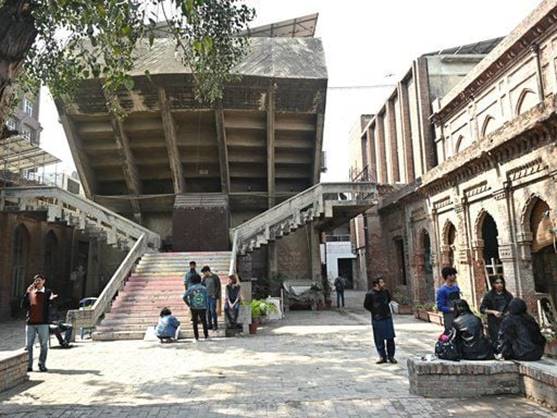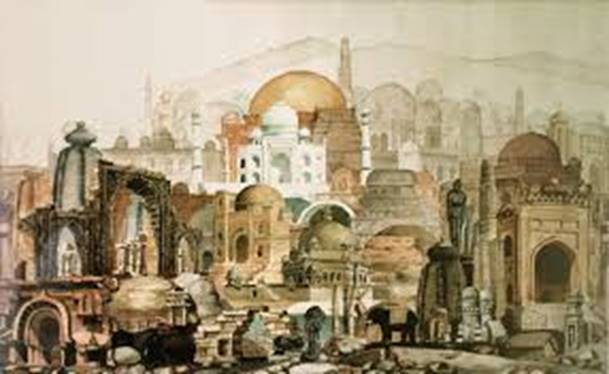
The ‘Manzar: Art and Architecture from Pakistan 1940s to Today’ is open for viewing at the Qatar National Museum in Doha, Qatar – Ocula
A Vision to Behold
By Rafia Zakaria
Karachi, Pakistan

Over the course of its tumultuous existence, the story of Pakistan has been told in myriad ways.
In keeping with the debate surrounding its very creation, the country’s ‘narrative’ has often been manipulated by enemies who wished for its annihilation, by dictators who sought control, and by terrorists and nihilists wanting to impose their own ideology. Poets and artists and activists have sought to unravel these malicious yarns with words and paint; not all have succeeded, though some have left a positive imprint.
A laudable effort to showcase the country’s talents was initiated recently and is ongoing. The ‘Manzar: Art and Architecture from Pakistan 1940s to today’ is open for viewing at the Qatar National Museum in Doha, Qatar. Designed by architect Raza Ali Dada, and curated by the team of the Art Mill, Qatar’s Museum of Modern Art, with Indus Valley School’s director of graduate studies Zarmeene Shah, Manzar was inaugurated by Prime Minister Shehbaz Sharif, the ruler of Qatar and Shaykha Al Mayassa Bint Hamad whose vision has been instrumental in creating a vibrant museum culture in Qatar.
Featuring some 200 works of art, Manzar presents the kind of multidimensional, multilayered and dynamic narrative of the country that can only be told through its art. It eloquently captures a moment of simultaneous triumph and loss as reflected in Salima Hashmi’s painting ‘Zones of Dreams’, which delivers a complicated texture of Pakistani history and visual culture.
Manzar does not limit itself to paintings, its multidimensional approach includes sculpture, architecture, and installations that together weave the tapestry of Pakistan’s visual legacy. While it is impossible to enumerate and mention the many iconic pieces included in the exhibition, one of the unmistakable stunners is Rashid Rana’s ‘The Red Carpet’. Viewed from afar, the piece appears to be a print of a beautiful and intricate red Persian rug. On closer inspection, it is revealed to be a mosaic compilation of hundreds of photographs of butchered meat. The beguiling red of the carpet is, in fact, an apt metaphor for the story of a very complicated country.
Also remarkable is acclaimed Pakistani artist Shahzia Sikander whose pioneering reclamation of Mughal miniature is presented through some resplendent pieces including two stills from her 2016 animation ‘Disruption as Rapture.’ Sikander’s work underscores the interpretive genius of Pakistani art and its ability to reclaim ancient form for modern times. Sikander, whose work has been exhibited everywhere from America to

New Zealand, is a prime example of a Pakistani artist who began her journey at the National College of Art in Lahore (the exhibition also pays homage to that historic institution which has nurtured Pakistani art and artists) and is now a global figure.
Halfway through the exhibition gallery hang two floor-to-ceiling pieces of velveteen tapestry. A rich emerald green, the work, which has been acquired by the Qatar Museum for its collection, has silver and gold embroidery around its border. This is artist Aisha Khalid’s ‘You Have Set Me Apart’. On the opposite side the deep and fiery red, betrays the tumult behind the green exterior. The great revelation of this masterful installation is not only in beholding the two sides, but by standing between them. From this vantage point, one can see that the piece is constructed of thousands of tiny pins, sharp and piercing.
One of my favorite parts of Manzar are the documentary installations that have been set up in one portion of the museum. Of these, architect Marvi Mazhar’s 30-minute documentary Milaap: Where salt meets the sweet water. Learning from indigenous knowledge and environmental social, spatial justice, women water, fractured relations, stands out not simply in its original content but also in its evocative rendition of Karachi’s contradictions. Installed in a bamboo pavilion, the salt in Doha’s air recalls thus a Pakistani city on another shore that has too often been erased or overlooked in the recollections and retellings of Pakistan’s art culture.
The art historian John Berger once wrote that the artists Van Gogh, Pisarro, Courbet, Gauguin and Delacroix were all in a sense militant — “militant to the point of being prepared to die for what they believed in”. They painted for a cause or to make intelligible a value that was likely more valuable to them than life itself. According to Berger, Van Gogh’s vision was humanity, while in Delacroix’s eyes it was beauty. In Berger’s telling, the men all “fought for their various visions and most of their energy was concerned with the difficulties of realizing their vision of finding the visual forms that would turn their hunches into facts. Each of their visions arose from the same kind of conviction; that life could be better, richer, juster, truer than it was”.
It is this sort of process, of realizing a “better, richer, juster and truer” Pakistan that one can witness in the pieces that make up the exhibition in Doha. Scattered through private collections around the world, these works had never been brought together in this way until now to tell the story of a country that reflects not just the attempt to show what is, but also what has been and what will be.
In his opening remarks, Prime Minister Sharif noted how the emir of Qatar in a phone call had mentioned that the curators were having trouble convincing some of the owners of the art pieces to lend the work to the exhibition. The PM apparently set his staff to the task of correcting this problem which thus led to the birth of Manzar. One wishes that this beautiful child could also be viewed by the millions whose struggles, desires and visions it so artfully represents.
(The writer is an attorney teaching constitutional law and political philosophy. rafia.zakaria@gmail.com Dawn)

